Geoffreyjen Edwards's Blog
November 17, 2023
Japan gleanings - textiles and poetry
During the course of most of October, I was traveling around Japan. It was my first trip to that country, after dreaming about going most of my life, and it was everything I had been led to believe. I went there as part of a research project (even though I am a retired scientist, I still get invitations from time to time), but took advantage of being there to explore several aspects of Japanese culture and geography that attracted me.
In particular, I have been nosing around an organization that offers to host artists-in-residence in Japan, including writers. The site looked interesting, but I thought, I'm going to be there, why not just go and see. It was in the Mount Fuji region, so I organized a bus trip from Tokyo, a place to stay for a few nights, and then I rented an e-bike to get from my hotel to the site itself. When I got there, I was treated with a certain amount of suspicion. I suppose I understand, a complete stranger poking around the property (I did knock but there was no answer, and there was a road up the back so I was headed up that when I finally saw someone). However, once I explained who I was and why I was there, I was invited inside to view the house and see the arrangements. The house is stunning, the view extraordinary and the arrangements in terms of studio spaces and so forth are awesome.
After I left, I started to think through more what I might do there. I showed the caretaker my work on the augmented reality belts in relation to my science fiction novel Plenum. I spoke about doing something similar. What I am thinking about is a weaving project combined with the work I have been doing developing poetry "from the future". The latter project is that as part of my 15-book science fiction saga, I am excerpting texts from poets not yet born who will be writing at various epochs between today and the time at which events take place in my books, roughly 2000 years of future history. So far, I have "invented" twelve poets, each with a distinct style of writing and subject matter, I have come up with titles for the works cited, and have written a sizeable number of texts. I intend to continue to extend this work, and use textiles woven in silk in traditional Japanese ways to create images used to anchor augmented reality representations of the texts.
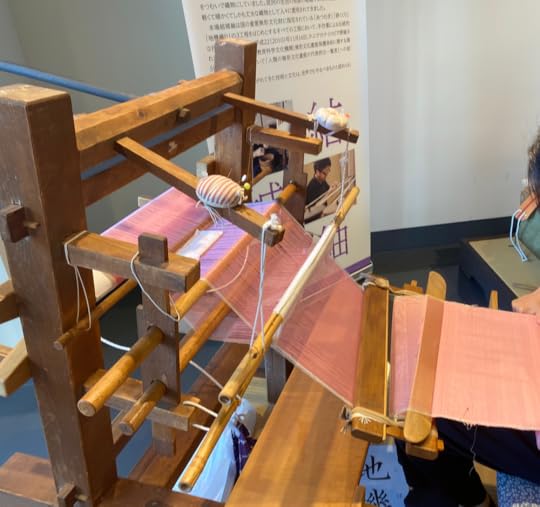
One of the projects the traditional weaver was working on. The loom is called a jibata, it is a kind of backstrap loom which uses the body of the weaver to ensure an extremely tight weave.
One of the other activities I undertook in Japan was to visit the site of the traditional silk weaving technique called yuki-tsumagi in a town called Oyama (and in Yuki City, its neighbouring town). Oyama is a stop on the shinkansen train run from Tokyo to Sendai, about a third of the way, and so it is easy to get there. Furthermore, there is a small museum just outside the train station showcasing the yuki-tsumagi weaving process. I spent the morning in the museum, which although small, contains a wealth of information. They unearthed some CDs with English explanations for me, which I really appreciated. Furthermore, I discovered that one of the traditional weavers was present on the premises. She was working on a couple of weaving projects as a kind of living demonstration of the process. Although she didn't speak much English, using the translation apps we were able to exchange a fair amount of information. I showed them photos of my work, the silk scarf I had woven, my dresses and corsets; they were overall quite impressed and came to understand how seriously interested I was in their work.
This served me well at the end of the morning when I discovered a number of the looms set up to act as participative demos of the technique. I rather gauchely asked whether I could do a demo, and it took some time for queries to go out and permissions to come back. Later I discovered that these demo activities must usually be booked weeks in advance and furthermore are not provided individually, which they did in my case. They set me up within the loom, as shown in the photo, which had been prepared in advance to allow one to make a silk coaster using the yuki-tsumagi technique. You can see the correspondingly narrow width of the weft in the image. Furthermore, the weft threads consist of a group of maybe a dozen threads wound together. In the traditional weaving, threads are placed one at a time. Grouping the threads allows one to create the coaster within about an hour. If one were to separate the threads, the same work would require more than a dozen hours, to produce one 10 cm by 10 cm coaster.
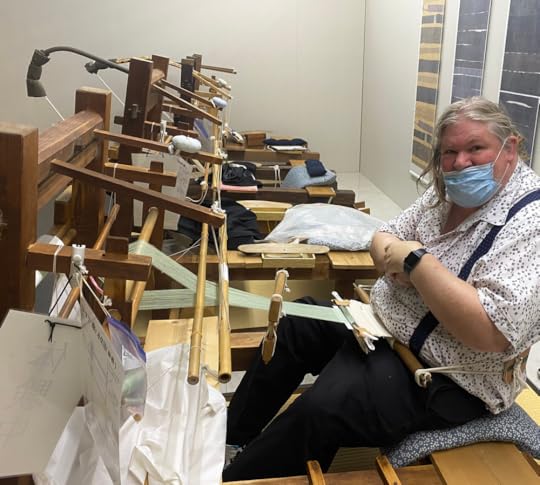
I am sitting inside the jibata loom with the belt harness tied around my back, and the work in front of me. My right foot is also held inside a cloth sling underneath (hidden in the photo) and this is used to raise and lower the shed each time to weave advances. There are two beaters in the process used to tamp down the weave and create a dense structure, the wooden beater one can see in the middle, and the shuttle itself (shown on the next table at the back) which is flat and is also used to tamp down the weave.
Furthermore, the weaver, whose name was Imaizumi Akiko, a relatively young woman, stood beside me the whole time I was working to help me remember the different steps, along with another woman from the museum. So I was coached through the entire process. The hour just shot by. I choose when to change colours and how many rows of each colour to weave, so the final coaster is, indeed, my own creation. Note that Imaizumi was very private, which I totally respected and I was careful to take no photos of her.
Now, I need to explain that although I have been saying that this was the yuki-tsumagi technique, in fact the name refers to a much lengthier and more complex process of which the weaving itself is but one of the final stages. The process as a whole involves sorting the silk cocoon to remove rougher threads, particular techniques for spinning (the thread is not twisted as is usually done in spinning), marking and dyeing. The sorting is worth highlighting, since it is what leads to the wonderfully soft feel of the textiles woven in this way. The thread is "marked" by tying threads to it in particular patterns, then dipping the thread in the dyes, and finally removing the ties so that the points where the ties were located now have a different colour. This is how the intricate patterns are generated in the finished weave - the location of the ties are determined before the thread is mounted on the loom using mathematical calculations or practical methods that do the same job (for those in the know, this is similar to Ikat weaving). The comb that is used to manage the threads is also unusually dense. At home on my table loom, I work with combs that are 12 teeth to the inch. The combs used here are 70 teeth to the inch. Indeed, the 10 cm width of the coast still consisted of 200 warp threads, which in my loom would correspond to a width of half a meter! Imagine the time needed just to set up the threads in a full width weave! So the whole thing involves a painstakingly long procedure. The training required to learn and master these diverse practices is therefore itself lengthy in duration - several years, typically. So the young woman weaver who assisted me was in fact someone who had years of training to be able to do this, and the weaving I did was a kind of a cheat, in that it was the penultimate stage of the process. Still, I felt that I had gained some significant insight into the yuki-tsumugi weaving technique. And I adored the experience completely.
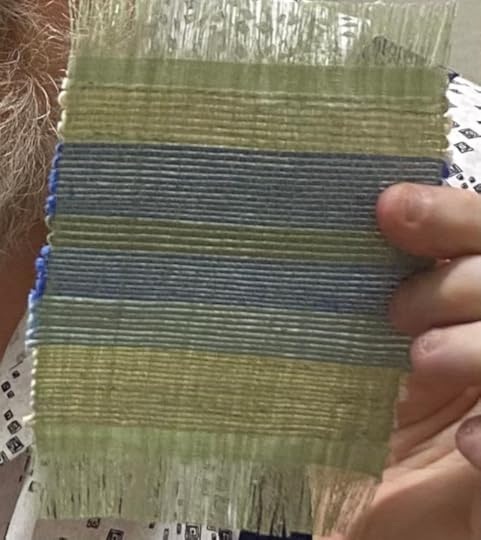
The coaster I made using the yuki-tsumugi weaving process on a jibata loom
In order to pursue my artist-in-residence project I have been investigating the possibilities of buying at least a back-strap loom, which is not so expensive, and doing some of that type of weaving so that I can better understand the process. The jibata loom is another issue, although I may know a place were I could borrow or rent one in Japan. So the project is taking shape.
April 20, 2023
Multi-Phasic Writing
As part of an exchange on TikTok with another writer, I have become focused on both the challenges and joys of my current life as a full-time writer. The comment was made that full-time writing is so hard that one should avoid it at all costs! Instead, one should take on a full-time job, and write in the gaps. I disagree, although I do agree that there are challenges to undertaking successfully full-time writing.
In my response on TikTok, I noted that as a former scientist with years of work on cognition, I have a good grounding in practices that allow one to keep energized. These include taking on part-time work in areas involving dramatically different types of brain function, switching between writing projects frequently, and tracking one's output. I also talked about taking part in co-writing groups with other writers, which I do both online and offline. In these groups, we sit together and write in parallel, not in general in order to share our work, just as a way of finding mutual encouragement. It all helps.
But further reflection has led me to the conclusion that another of the tools for a successful full-time writing career, at least in my case, is to have a range of writing projects that are at different stages of development. I hinted at this in my last post. My Regency project is in the early planning stages. "Splicer", my time travel novel, is in an advanced stage of developing the first draft. "Goodness in Small Doses" is undergoing the final stages of revision, along with "Messioph", while "Apprentice" is undergoing revisions at an earlier phase. "Plenum", of course, is in the marketing, post-publication phase. Hence there is an entire production cycle going on here. And I love it. If the work starts flagging in one area, then I switch to another. And because I track my time, I know how much time I spend writing, how much marketing, etc. In the figure below, you can see how much time I spent in April at these different tasks, for a total writing time of about 140 hours as of April 20. There is an exhileration in writing in this way. And productivity is consistently high, bringing additional satisfactions.
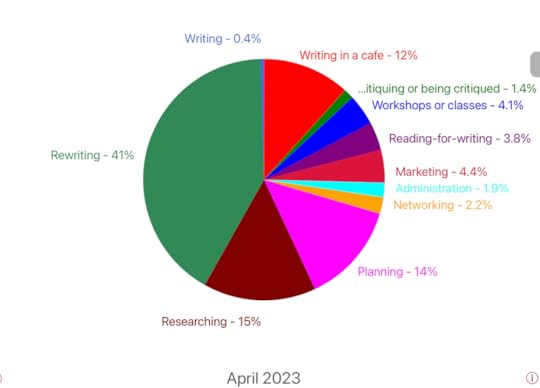
April 7, 2023
Regency Renditions
One of the aspects of writing I have known for some time, but neglected of late, is that I need to have new projects, not just the older ones. The latter require massive efforts at the level of revisions, and I have come to appreciate the revision process. It results in dramatic improvements in the books, especially when other editors are involved. However, the process of revising never seems to achieve the sheer exhilaration one gets when developing a first draft, when the writing leads you into discovery of unsuspected aspects of your own writing. In my efforts to get my books out in the world, I have spent the past two or three years almost uniquely focused on revising. This has led to the completion of two manuscripts for publication, and two more almost ready to go out, plus three more not far behind. Pretty damn good!
But I need to get back to the exhilaration of writing, and for that I need "new". Well, it doesn't have to be completely new. It could be a half-completed manuscript that still needs a lot of "first drafting". My Zoroastrian time-travel thriller, now called 'Splicer', for example, still needs significant chunks of that kind of writing. But because that manuscript is already well-established, it needs several sizeable bouts of sustained writing, and right now I still have several revision efforts I need to complete. What I need is a project involving a lot of background research, which I can undertake in parallel with my other projects. I love doing research, too; I was an academic researcher for 40 years, so hardly surprising.
Just as my time travel thriller came out of a kind of "dare" a writer friend of mine threw at me, my new project is also the result of a similar discussion. For the past year I have been reading what are euphmistically called "Regency romances". Think Bridgerton, but also Jane Austen (I've read all of Austen and six of the eight Bridgerton novels). My writer friend oriented me towards Georgette Heyer's writing - she single-handedly "invented" the Regency romance in the 1920s and 1930s. I had read some of her books before, but not so much the Georgian and Regency books. But like the time travel project, I have to do something very different from the standard fare. I can't follow recipes in cooking, and writing is no different.
So without yet having a plot, what I have is a context, and one which is rich in multitudinous details. First, the Regency period itself, named after the mental illness of King George III led to the naming of a regent to oversee the kingdom in 1811, who remained in power until the ascendance of George IV to his father' throne in 1820. Geoge III was married to the mulatto Charlotte, also a highly influential figure.And what an extraordinary thing to have a period named as a result of dealing with mental illness! Charlotte herself was a symbol of the 20000 or more blacks in England at that time, largely as a result of the slave trade which was still in full swing. The Regency period also coincided with the rapid development of the Industrial Revolution, involving not just iron and steel manufacturing but also textile mills, the beginnings of the railroads, newspapers and magazines, food production, banking, etc. This is hardly mentioned in either Austen or Bridgerton, or indeed, the Heyer novels, and yet was a hugly important period of economic growth.
In the Regency novels of the different novels, fashion plays a major role. However, the focus in these books is on the "modistes" who worked for the aristocratic classes primarily. Fashion underwent significant change over this period, partly as a result of the growing availability of cheap cotton from the mills (whose raw materials were harvested offshore largely by slaves, in the plantations in the Carribean and southern United States). Clothes became "democratized" to the masses, and there was a strong market in second-hand clothes even among the wealthy, as a result of the durability of new textiles such as wool worsted that were being mass-produced. Now, I make no secret in these pages of my passion for clothing and textiles. The idea of developing a novel, or novels, focusing on the fashion industry at this time leaves me panting with excitement.
The third element where my own life story crosses the events of this period is the presence of a sizeable and highly influential community of Quakers in England at this time. Many were captains of industry; indeed, the Quaker community of that era was split between those who owned and exploited slaves and those who had become virulent abolitionists, and so the Quaker community itself embraced those contradictions. Similarly, the larger part of the community was plain-speaking and focussed on a restricted range of fashions and activities, while others, the so-called 'gay Quakers', were more openly worldly. As a 21st century Quaker, I am fascinated by Quaker history and this aspect of the era also appeals to me.
So what kind of story will emerge from this confluence of ideas and contexts? At the moment, the answer remains unclear, but it will likely not follow the "classical" formula of regency romances as developed by Julia Quinn (author of the Bridgerton novels), Heyer or even Austen, who seems to have had a more nuanced attitude towards fashion, for example. I need to find my own way. On the other extreme, one has novels such as those developed by Delderfield concerning industrial developments over the same period - he wrote extensively about the carting industry from a historical novel point of view, romanticized in its own way. And it seems likely that my writing will include black representation as well as gay romance (in the other sense!) and perhaps also gender fluidity.
But right now I'm having fun with the research, which I can do inparallel to my efforts at revision. The rest will have to take care of itself.
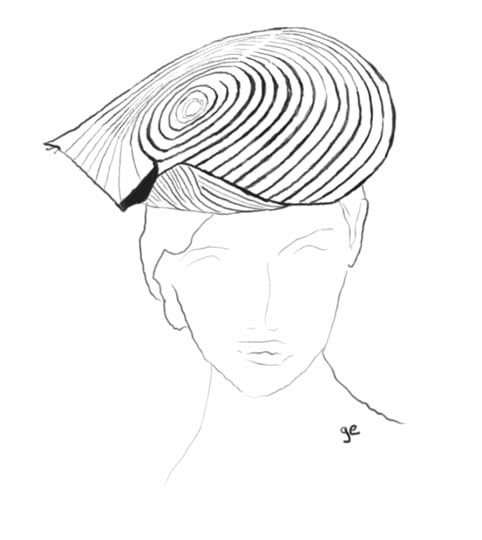
January 10, 2023
Prospects for 2023
I realize I have been silent here for several months. It has been a busy time. My writing is moving forward on several fronts (think weather, not war!). I am finishing up the revisions to my second volume in The Ido Chronicles, the novel Messioph: The First Book of Ido. These were revisions in response to editorial remarks and suggestions by the three editors at Untimely Books who have been providing oversight on my work. It has been a challenge. The book is, I think, more substantive than Plenum in several ways, and addresses issues that require careful thought to get right: issues such as child abuse and the lifelong difficulties of recovery this can pose. That story is wrapped up inside others that concern the cosmos and our place within it; the mix is, I think, potent.
I have also decided to develop a proper newsletter. Participants of this site (geoffreyjenedwards.com) will have found my presence here spotty. I have been struggling with technical issues related to the site, in particular, the way membership lists are managed by Wix and its widgets. The development of a newsletter will, I believe, resolve these issues. Services such as MailerLite or MailChimp provide robust management of email lists in support of newsletters, and so I expect to develop a much more consistent presence without the security issues that have been plaguing this site. I will keep this site, but it will be complemented by the newsletter.
However, a newsletter is its own thing. I have been reading how-to books to find guidance on procedures, and developing support elements, such as emails that can be sent out automatically, and also what is called in the business a "reader magnet". This is a story related to my novels that will be offered exclusively to newsletter subscribers as a way of attracting new readers. I have been developing a short story about the jonahs that will serve that function.
On Amazon and Goodreads, reader reviews have started to appear for Plenum. They are all, so far, at the four- to five-star level, which is gratifying. Sales are still slow, but I have also started doing book fairs, such as Montreal's Holiday Book Fair shown below, which extends readership through personal contact. Although that is hard work, it is also gratifying. Most people find the story synopsis interesting and even when they don't buy, I find there is a connection.

On Tiktok, just before Christmas, I gained more than 1000 followers. This milestone is important, because it provides access to other parts of Tiktok, and in particular, the live streaming service. I am hoping to connect with other writers to do some live streams about writing, and I have also launched some live streams that look into my illustration efforts in relation to my novels. My engagement on Tiktok is hardly viral, but 1000 followers in 8 months is still pretty amazing in my opinion. On Twitter I have over 3.5K followers, but I have been on Twitter for over ten years. I don't think my followers will have much impact yet on sales, although certainly there have been some as a result of my presence there.
As for prospects for the year, in addition to the projected publication of Messioph, I have a third novel in the wings ready for submission: Pinnacle: The First Book of Eng. As the series of 15 books, The Ido Chronicles, slowly gathers steam, I am expecting a livelier discussion with readers about the diverse issues it addresses, especially with the impending launch of a newsletter. I am also expecting to finish the screenplay I have been working on, which deals with a prequel to the Chronicles called the Third Testament. There is a possibility of forming a group to read the screenplay aloud, which will provide interesting feedback for improvements. I don't like to say more about my other projects. Readers of my blog will be aware there are several, but my priority at the moment is to get more of the science fiction saga out into the world before moving forward in other areas. I have the sense that 2023 may be a booster year for my writing as I consolidate the work already done and get new work out.
September 8, 2022
On Writing a Screenplay
I have been looking into the process of writing a screenplay for some time. I have taken several classes on the subject, and thought hard about what I would write about and how I might do so. I had one project in mind to do a biography of Thomas Hardy, and I'm still holding out for that one, but there is such a lot of research that is needed to support the project, it is in a slow spin. Instead, this summer, after finishing my work on revisions, I decided to try my hand at a screenplay in relation to my book manuscript Third Testament.
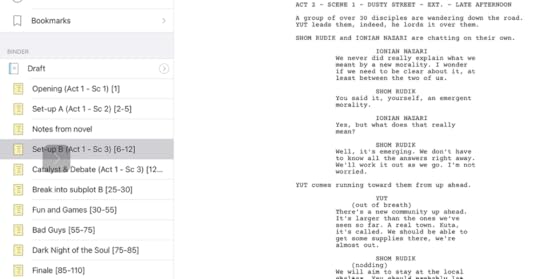
Third Testament is a prequel novel for The Ido Chronicles. It describes the so-called Emergentist Rebellion, which took place at the end of the Second Exodus, more than a thousand years before the events of the Chronicles, and that led to the creation of the document called the Third Testament, cited by almost everyone in the Chronicles. I had already presented the overall story to the folk at the Synagogue in Quebec City, and they had been enthralled. One of their number claims to have an "in" with someone at Netflix, and we talked about doing something further with the story. But it would be good to have a screenplay in hand before doing so.
In my courses on screenplay writing, I was told repeatedly that the only real way to learn how to write a screenplay is to plunge into the process. There is, however, a narrative structure, called "Save the Cat", used by both screenwriters and novelists, that could help organize the project. So I adopted the Save the Cat format (you can see this in the panel on the left in the figure, which has broken the process down into page ranges for each structural element), and made a stab at it. My first efforts focused on the historical framing of the story, but I have decided that that is too complicated, and have turned back to the basic story as presented in the novel. However, that is probably too large for a single TV episode. I may end up proposing a small mini-series instead. We shall see.
The structure of a screenplay, and the process, seem quite different from those involved in novel writing. Everything is compressed in time and place, and the thought processes one can dwell upon in a novel need to find expression in other ways, as dialogue or as visuals. Descriptions of places can be present, but they need to be short and pithy. What I've been doing is copying over passages from the novel and then restructuring them for the screenplay. It is a long and challenging process.
Most people seem to think writing a screenplay is easier than writing a novel, and I guess in terms of overall time involved, they are probably right, but I find the job not at all easy. Maybe it gets smoother with practice. I certainly feel I am learning a lot by doing this. Perhaps my first screenplay will not pass muster, but it is an important step in the process of learning to do this. I don't plan to write tons of screenplays, but I do want to understand what is involved, perhaps with a view to overseeing someone else doing so with my novels.
July 29, 2022
On Palimpsests
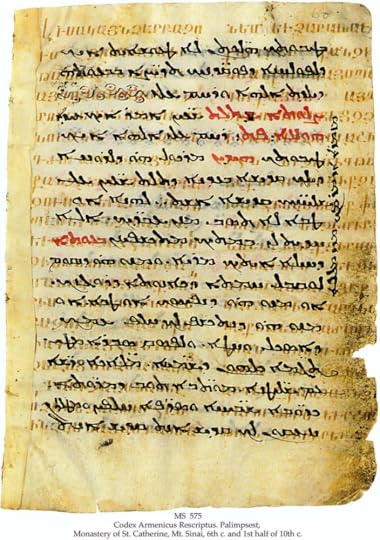
The idea of a palimpsest has always intrigued me. I'm not sure where I first encountered the term. Certainly it was part of my sense of wonder reading Umberto Eco's Baudolino, all the more so since I read the book in the Italian original with a great deal of effort (my Italian is not so strong). But what I want to notice in these pages is that, in some sense, all writing is palimpsestic (probably not a word!). It is one of the properties of writing that both disturbs and charms me, and I have noticed that many writers seem to either be ignorant of the issue or that they simply don't care, although it preoccupies me immensely. In fact, the problem is present not only for writing, but also for memory itself.
Let us reflect for a few moments on the term itself (while being aware that that sentence is itself indicative of the problem!). A palimpsest, according to the Oxford dictionary, is "a manuscript or piece of writing material on which the original writing has been effaced to make room for later writing but of which traces remain". The word combines the sense of "again" (latin palim) and "scrape" (latin psestus). In Baudolino, the narrator is reportedly writing the novel on a pre-existing manuscript by scratching out the words already present and writing in the new words on the intervening lines.
Another writer who plays with ideas such as this is Samuel Delany, to whose Neveryona series I have recently returned. Since Delany called Neveryona, a "child's world of semiotics", it seems hardly surprising that his work should be cited along side that of Eco, another noted semiologian. In Tales of Neveryona, Delany describes a process of copying and inversion of a text, from the original symbols, to a mirror version where the order of symbols are reversed, and then a second reflection that reveals not the original text but an entirely new one inscribed on the backside of the original sheet.
He then presents a lengthy discourse (in the Tale of Old Venn) where the narrator describes having encountered a sea monster while alone on a boat, then describes the experience to a group of listeners, and then recounts the story again the next day. In the original encounter, Old Venn was preoccupied with simply surviving from one moment to the next, but in the first retelling, that is not the sense the audience remarks upon, rather they are fascinated by the fact that Old Venn survived the encounter. That is, clearly she survived in order to tell the story, as opposed to struggling to survive in each instant of the encounter. Delany is making the point that the retelling is very different to the experience itself. Then, when Old Venn tells the story the next day to a new audience, now she has re-ordered the events and restructured the story to make it easier and more effective to "tell", and this again changes the nature of the experience for the second audience. You get the idea.
What Delany is describing is the various ways by which the telling of something is different from the something. And in each retelling, we have something like a palimpsest, where the trace of the earlier is present within the rewriting. Now, why do I say that all writing is a kind of palimpsest? Well, not only does the act of writing involve the kind of transformations Delany describes, but writing itself is never completely divorced from the body of previous writings. A novel is necessarily constructed with both implicit and explicit references to previous novels and other forms of writing (such as books about the writing process). This is why I have trouble with any and all affirmations that a story being told is "truth", or a "true story". The very act of turning events into a story involves the transformations Delany talks about. There is no way to tell a story without doing this. And story-making is rather more the result of the second kind of transformation Delany describes than the first kind, that is, it involves reordering events to support the telling.
The process whereby our day-to-day experiences are transformed into memories also shares similar transformational properties as does that of a retelling. The memory of something is not the something itself, and memories also leave traces when they are overwritten by other memories. And writing does to memory the same kind of retelling. Another of my reasons for finding autobiographical writing to be difficult, since the re-telling generally changes the original. Memory is not some fixed thing, it changes as we access and process its contents. I used to take a set of watercolour paints with me when I traveled, and painted things rather than photographing them, aware as I was how photographs "fix" memory in sometimes pernicious ways.
As a result of these reflections and the awareness they bring, I do not consider writing to be, ever, a "thing-in-itself". A fictional novel exists inside a set of conventions that direct readers to think about the experience of reading in particular ways. These differ from the ways of oral storytellers but share a common bond nonetheless. And although it is expected of me by many readers, I have a hard time "keeping within the lines", that is, respecting the conventions. I always want to break outside of them. Of course, much of modern literary writing, from Woolf to Joyce through Pynchon and Calvino and many others, does exactly that. But many readers are uncomfortable with the process of readings texts that break with these conventions.
And "the writing that effaces other writing while leaving traces" might also be a fitting description of the process of revision, or at least for certain aspects of the latter. Technically, it is perhaps clear that the notion of a palimpsest is not meant to describe revision, but one can see the lineage between the two. And this brings me back to my own writing practice, and the point of this posting. Originally, when I started writing, I was writing what one calls "first drafts", that is, laying out the initial material, the plot, and broad strokes of the characters, setting, and so forth. Now, of course, because I did a lot of first drafts, most of the writing I have to do is revising. I have learned that I need at least one "first draft" project to balance out the different calls upon my time, since there is a kind of rush associated with the production of a first draft that is very different from the careful and highly iterative work of revision.
What I have learned to do, as a compromise between "writing between the lines" and "breaking free from the rules", is to embed a kind of play of "writings about" within my novels. Hence, for example, my science fiction is couched in historical terms - it is interspersed with remarks by historians commenting on the events as they unfold. Interestingly, my readers like this too. It seems the discomfort that comes with breaking free completely from the rules is absent when one does this kind of commenting-upon within the context of the fiction. It is another way of working with palimpsest in its metaphorical sense. As long as the nesting level (ie. text about text that is about, etc.) is kept to a minimum, the practice works. I won't promise that I will always work within the lines in this way, but I will do my best to keep disruptions to a minimum.
June 29, 2022
Booktok or Bust
For the past two months I have been posting regularly on Tiktok. I read that it provided interesting opportunities for making known (i.e. marketing) one's book, and thought I would try it out. I have had an active presence on Twitter for over ten years. It seemed a good time to make the effort to explore another social media platform. I read up on Tiktok, and the pundits suggest posting from 3 to 5 videos a day during the first month of using to platform in order to develop a presence that will drive, essentially, visibility, which is the result of the rather mysterious operation of the site's algorithm. It is clear that this algorithm does follow a system, but guessing exactly what that system is, poses problems. Anyway, I took the advice to heart, and although I felt squeamish about filming myself so heavily, I took the plunge.
I have actually started to enjoy the process of presenting myself on video, although there are days it is hard to muster the interest to follow through. Tiktok handles video clips up to 15 seconds, 1 minute, and 3 minutes differently. For new users of Tiktok, it is not possible to post videos longer than 3 minutes. So one learns to be concise. However, there are a lot of tricks one can do, via video editing, to enhance the clips, many of which take advantage of the way Tiktok works.
At its root, it was developed as a way for users to lipsynch song lyrics. Today it is used much more broadly than that, but its lipsynching features are still present and often used to advantage. Hence, for example, instead of synching to songs, one can synch to recordings of actors' lines in films or even to recordings from other Tiktok users. There are hundreds of sound tracks that are repeatedly used in this way. Sometimes these are just noises that are used to highlight messages, for example, a series of bells ringing, and text boxes are used ubiquitously also to draw attention to issues (such as books). It is a highly playful environment, and demands a great deal of creativity to use fully.
Although there are users who have clearly adopted a persona rather than present themselves directly, I would say that the majority find a way to "be themselves" in whatever way works for them. As a writer, this appears to be the way to go. Over the two months I have been active on the site, I have gained about 420 followers. This is probably average in terms of growth. Some people gain followers much more quickly, usually as a result of finding a "winning formula", but sometimes just as a result of who they are. For example, those who are more playful tend to do better. Women may do better than men, but this is not always a good thing. As a writer, one is trying to build a community of interested readers and fellow writers. If one attracts people to one's pages for other reasons, these followers may end up causing problems, as they will bias the algorithm that promotes visibility towards the wrong audience.
Like others, this causes problems for me because of my eclectic interests. It has become clear that my "writer's account" should probably be kept separate from my "fashion designer's account" so as not to confuse the algorithm. On the other hand, my gender fluid advocacy seems to be good for my book promotion and for my fashion design stuff as well. Finding the right combo is very much a case of trial and error.
As a new user, the first major milestone one tries to achieve is to get to 1000 followers. Some of the more advanced features of the site are only available to those with that level of followers, including the ability to hold live seances, and the ability to receive donations from interested viewers. Indeed, there is a way to earn an income via the site, although only the most popular users are able to generate an income that is significant. Live sessions are interesting to writers because they allow us to take more time to read aloud, say, or to carry out interactive sessions involving story-telling.
There are writers who have been successful at generating follower communities that significantly affect book sales. In the most successful cases, these can be substantial. However, I suspect that for most writers on Tiktok (or Booktok - the part of Tiktok devoted to books), the impact on sales is much more modest. Still, for struggling writers newly published, even a few book sales can make a difference and can help build one's credibility as a writer, especially if this leads to book reviews and the like.
As for myself, I am rather enjoying the whole exercise, still, although I imagine one could tire of the whole effort. There is still so much to learn about how to use the environment. Also, I enjoy it rather more than Twitter, Facebook, or even Instagram, all three of which I use as well. I get to talk about things that I am passionate about, and so far, the followers seem to come just as a result of saying those things. Many users of Tiktok don't actually post videos - I estimate that is the case for about two thirds of my followers. They are just people interested in one's voice but don't, for whatever reason, wish to express themselves via video. I titled this post "Booktok or Bust" but although I think one could go all out on Tiktok, that is not necessarily what I wish or plan to do. I will stay with it as long as I have fun, and if it helps sell my book(s) as well, then so much the better.
N.B. My TikTok account is @geoffreyjen_author

April 6, 2022
Rethinking my Own Book
As my novel goes up for sale, I have started to receive reviews and reactions. I know this is the lot of any writer who publishes. The book enters the culture and becomes something else. However, what has surprised me is that my own understanding of the novel has started to shift. I thought I knew my own book, but although the reviews highlight elements I can confirm are present, they change the emphasis placed on those different aspects and the result is that my own awareness has changed. For example, one reviewer has pointed to the dichotomy that exists in the book between history and story. Now, this was intentional on my part, as a way to frame the story. I am interested in different ideas of truth, and it seems to me that history, with its different framings, offers an interesting perspective on truth. Hence I built that into the books (I say books, because there will be 15 of them - the 2nd and 3rd are in the works for publication in the near term also). But the idea that there is a dissonance between history and the story itself, that is not something I consciously thought about. Now, I will, for the next books in the series!
Another insight I got from the reviews. One person remarked that the linguistic neologisms I introduce feel intuitive, that they don't jar the reader. That was also intentional, although I was unsure of the extent to which I had achieved my intention. It is highly gratifying to see this comment, because it is something at which I worked hard to achieve. But having succeeded, I am now drawn to reflect on what that means. Linguistic fluidity has its own kind of power, and it is something I feel I need to understand better for the rest of the series.
The Kirkus Review was really interesting, because they had no prior exposure to me as a writer. They clearly understood the book, with its interplay of themes around sexuality and spiritual awakening. But here, too, I have started to question the consequences of that recognition. The remainder of the series will have to grapple more fully with these issues. Well, they already do, of course, since the draft manuscripts are almost complete for all of the 14 later books and the issue is taken up again throughout, but still, the arrival of the theme into the public domain heightens the importance of the work.
Finally, two different reviewers point to the "keening" presence of creatures whose presence fills the book, the jonahs, descendants of the whales from Old Earth, and that their lives resonate with those of the characters themselves. This is an aspect of the book which was the result of my intentions, and yet, here again, the strength of the resonance as perceived by these different readers surprises me. What is interesting about this is that the story of the jonahs became more important the more I wrote. They played a relatively minor role in the original drafts. Now they feature prominently also in the second volume currently under review by the publisher (called Messioph: The First Book of Ido). There are a number of "emergent" ideas and themes in the whole series that weren't there originally - indeed, the whole religious element was such an interloper.
The depth of my reflections about my own book brought about by these various comments about the book have taken me by storm. I thought I understood what I had written. I now realize there are whole vistas that are opening up in the story as a result of this interaction with readers. And this is still only a few of the latter - what will happen when there are hundreds of them? Perhaps this process of rethinking is normal, but if it is, why don't writers discuss it more often?
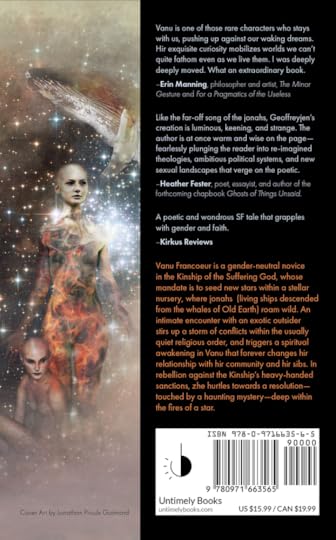
January 24, 2022
Publishing in the Round - Untimely Books
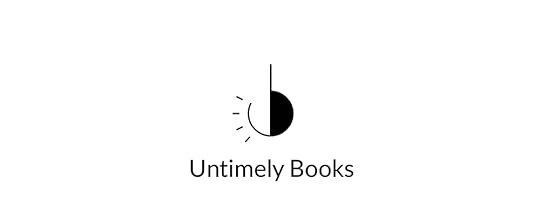
One of the reasons my book Plenum has taken such a long time to bring forward into print is that, along with other members of the Infinite Conversations/Metapsychosis community, we have also been busy launching the book publishing agency itself. Called Untimely Books, this has involved drawing up incorporation papers for the larger entity as a cooperative (Cosmos Coop) endeavour, within which Untimely Books, Metapsychosis and other projects are sub-activities. The group has been operating for several years effectively as a cooperative venture but outside any legal structures, simply on the basis of good will involvement of a core group of people. In order to publish, however, it was necessary to formalize these arrangements so that a legal structure exists for drawing up book contracts and so forth.
The larger organization is itself an effort to create a shared space for creative endeavours of which publishing is just one possible output. However, the vision for the publishing house is itself interesting, above and beyond the larger goals fo the group. Indeed, the world of publishing is still sharply polarized between traditional publishing which handles most aspects of book production but only gives a return on investment to its authors of 10% to 15% of total sales, and so-called independent publishing ("indie") where authors publish their books directly onto distribution platforms such as Amazon Kindle, and may recover up to 70% of sales. The difference sounds huge, and, indeed, for an author who sells thousands of books, this amounts to a large difference in real dollars. However, it is generally acknowledged that most new authors will be lucky to sell more than a few hundred books on their own, and at this level, with the outlay needed to produce good quality books, the indie route may result in debt rather than revenues.
The idea of a cooperative publisher therefore offers a middle solution that is not only exciting, but potentially meets a real need. The cooperative shares the production process with other creative individuals - other authors, illustrators, designers, actors, readers, editors, and so on - so that individual authors are not required to do all the legwork on their own. In exchange, revenues are shared to other members of the coop. The total amount pocketed by an individual author is therefore closer to 40 or 50%, considerably less than if they did the whole process themselves, but they will recover some of the other costs via the cooperative venture, as well as functioning within a community of people excited by the process of publishing and creating. A cooperative is also markedly different from other offerings in the middle ground between traditional publishers and Indies. Hence, for example, a number of business offer "help" with the publishing process for prospective indie writers, but separating well-intentioned help from the many scam offerings that exist makes the whole production area a mine field. It is our hope that a cooperative venture can offer a safer haven to writers going the non-traditional route than most of the existing choices.
That said, our project is not simply a publishing venture, but publishing as a part of a wider community focused on diversity, visionary thinking, and creative sharing. Our model seeks to create incentives for participation within the larger community, hence the title of this posting, "publishing in the round", in the sense that everything we do circulates within our community. We do not wish to attract writers who will come primarily in order to "get published", that is, take advantage of the resources available without giving back to the larger community. This poses its own challenges.
Another way this is "in the round" is that the cooperative venture is in the process of organizing around principles of sociocracy/holacracy, hence a horizontal governance structure organized into networked circles. Decisions are carried out within domains and not necessarily propagated up through a hierarchy. Untimely Books is therefore itself a circle connected to the wider circles of the coop. We are still untangling how this all works, but in principle it should encourage more sharing of power.
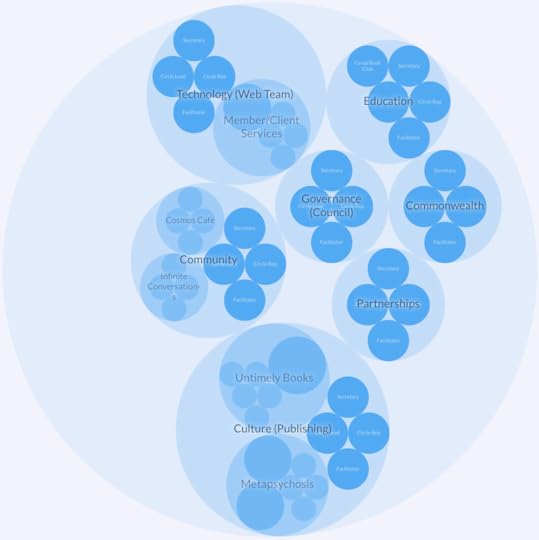
Proposed holacracy circle diagram for the Cosmos Cooperative
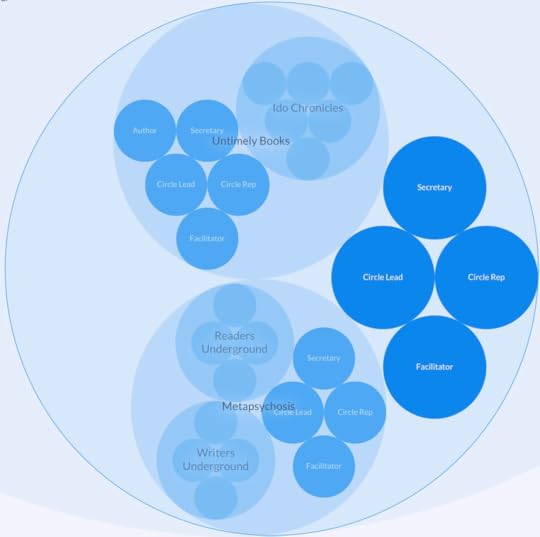
Holacracy structure for Publishing within the coop; note that The Ido Chronicles will have its own circle
Also, as a new publishing venture, there is so much to learn. As I keep saying to friends, "them is us". There is no "they will do it for us", rather we have to discover all the myriad efforts to be undertaken ourselves. There are guidelines for this, and lots of information on the net, but there is still a lot to learn. The effort should yield rewards, however, in a process whereby we ourselves are masters of the publishing process and are part of a dynamic community of writers and other creatives working together. Indeed, Plenum would never have gotten this far without not only the help of this community, but also their enthusiasm for the project.
November 5, 2021
Little Russia
During the month of November I am participating in the worldwide annual paroxysm called NaNoWriMo, the National Novel Writing Month. Here in Quebec City, about thirty people participate each year. You would think they would write in French, but although the activities are all carried out in French, most write in English. I think it is partly the youth culture. Many write fan fiction. There are some serious writers working towards publication or maintaining published works, but many participants seem to do it more for the pleasure of writing, or as a personal challenge. I enjoy being connected to this group, and my creative production is certainly amplified in November, but I rarely have difficulty turning out words, so generating the required 50000 words is no great challenge.
This year, with Plenum in press, and Messioph submitted for evaluation, I have decided to work on the expansion of my novella, Goodness In Small Doses. I may have mentioned before that this manuscript of about 28000 words attracted the interest of an agent during the spring 2020 #PitMad exercise on Twitter. However, after reviwing the full manuscript, the agent pointed out that it was really more a novella than a novel, and that given its difficult subject matter, it would be hard for her to market, and therefore she declined to pursue the project. It is worth remembering that the book was written during the Three Day Novel Contest and was based on field work I carried out in France in the summer of 2016. I had intended to write about the "rescuers", people who had put their lives at risk to help refugees from the Nazis during the Second World War, but I had also been attracted to the plight of people with disability, especially children. In the version that found itself worked out on paper, the story focussed more on that issue than on that of the rescuers, who had been my initial focus. So with the feedback from the agent, combined with my own desire to write a book that more fully addressed the motivations of rescuers, I decided to devote this year's NaNoWriMo exercise to expanding the novella with an additional 25000 to 30000 words. To make up the 50000 words needed for NaNoWriMo, I also propose to advance my Clangworld YA project and maybe do some more work on Face Down, my historical thriller. And I guess this blog posting adds a couple hundred words into the mix as well.
Now, without giving away too much in the way of spoilers, the manuscript as already written deals with Mags, a young girl with cerebral palsy, and her Jewish Belgian parents who are fleeing Brussels and attempting to cross the Demarcation Line, the artificial border created by the Nazis that cut France into two pieces (actually there were a few other pieces as well), the occupied zone in the north directly under the Germans, and the non-occupied zone under the authority of the French government, which largely cooperated with the Nazi regime. Escape from Europe was possible (although difficult) through port cities such as Lisbon, but to get there you needed to cross the Demarcation Line first, then make your way to the Spanish and Portuguese borders. Goodness in Small Doses focuses on several individuals in the region around the town of La Rochefoucauld, just outside Angouleme, mostly members of the same family. The story then jumps to a second section dealing with events near Toulouse towards the end of the war.
To expand the story, I develop the backstory of another member of the same family who was already mentioned in the first version of the manuscript. This person came close to being a collaborator, but also provides insight into the other members of her family. Through the involvement of this character, I also introduced a section in the middle of the book dealing with resistance groups (the beginnings of the maquis) in the Limousin region. This region, which became a hotbed of resistance cells, was called 'Little Russia' by the Germans later in the war, since the difficulties they encountered there were reminiscent of the problems the Germans encountered in Russia. Since this section is still under development, it is difficult for me to say more at this time. All this writing requires a collossal amount of background research, sometimes dealing with specific incidents, but more often than not just providing a sense of the times and places and cultural tissue of the times. Also, the field work I did in 2016 has played a substantive role in giving the story more realism and a better anchoring in the region's geography.
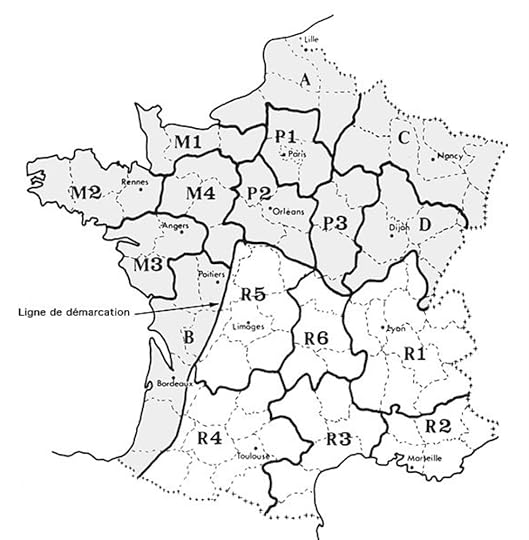
Limousin region of the French Resistance was R5, called by the Germans, "Little Russia"
The result of this effort is, I believe, a fascinating portrait of the complexities of the experience of living in that period in wartime France.



